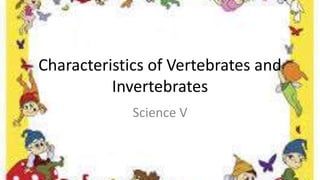
Characteristics of Vertebrates and Invertebrates (39
- 1. Characteristics of Vertebrates and Invertebrates Science V
- 2. What are the two big groups of animals? Review
- 3. Give 2 examples of each group of vertebrates and tell the characteristics of these animals. Checking of Assignment
- 4. Go to your own group and work on the characteristics of the animals. Work cooperatively to classify the animals according to their characteristics. Motivation
- 7. 1. animals with backbones 2. animals without backbones 3. warm blooded animals 4. cold blooded vertebrates Motivation
- 8. 1. Group the animals into vertebrates and invertebrates. 2. Work on the characteristics of these groups of animals. Group I - Vertebrates Group II - Invertebrates Presentation
- 9. Presentation and discussion of the report. Concept Formation
- 10. What are the characteristics of vertebrates? Invertebrates? Generalization
- 11. What are the characteristics of invertebrates? Generalization
- 12. 1. Fish are ectothermic, aquatic vertebrates. 2. Their skin is generally covered with scales. 3. Their limbs are modified into fins for swimming. 4. They breathe with gills. 5. They lay eggs that must be in water. Generalization
- 13. 1. Amphibians are ectothermic vertebrates. 2. Their skin lacks scales, hair, and feathers, and is either smooth (like a frog) or rough (like a toad). They are dependent upon moisture and subject to desiccation; their skin must remain moist to aid in breathing. Generalization
- 14. 3. They lay eggs in water, which hatch into an intermediate life form (tadpole or larva) that usually breathes with gills, and change into the adult form that breathes air and can live outside water. 4. They have three-chambered hearts. 5. They lack claws on their toes. Generalization
- 15. 1. Reptiles are ectothermic vertebrates. 2. Their skin has scales, but no hair or feathers. 3. They have three-chambered hearts (except for alligators and crocodiles, which have four- chambered hearts). Generalization
- 16. 4. They have claws on their toes (except those which do not have legs, such as legless lizards). 5. They are the first animals, in evolution, to develop the amniotic egg. This allows reptiles to lay eggs on land. Generalization
- 17. 1. Birds are endothermic vertebrates. 2. Their skin is covered with feathers. 3. They have four-chambered hearts. 4. Their bones are lightweight and usually hollow. 5. Their forelimbs are modified as wings. 6. They lay eggs. Generalization
- 18. 1. Mammals are endothermic vertebrates. 2. They have hair, which varies greatly among species. 3. Most have sudoriferus (sweat) glands. 4. They have mammary (milk- secreting) glands. Generalization
- 19. 5. They have sebaceous (fat- secreting) glands. 6. They have heterodont dentition (different types of teeth). Generalization
- 20. “Ectothermic" means "external temperature" in Latin. The simpler term is "cold-blooded", that is, it has a body temperature equal to the surrounding environment. You know that fish are cold-blooded if you ever picked one up: they are as cold as the water they were swimming in. Generalization
- 21. “Endothermic”, which is Latin for "inside temperature" means that they can maintain their own warm inside temperature, even when it is cold outside. Frogs (amphibians) and snakes (reptiles) have to hide when the weather is cold, but birds can be out and active because they are endothermic. Generalization
- 22. Some vertebrates are warm-blooded animals or endothermic vertebrates. Some vertebrates are cold-blooded animals or ectothermic vertebrates. Generalization
- 23. Invertebrates are animals without backbone. Some have jointed feet, no bones, they have hard covering called exoskeleton, some are soft-bodied animals, segmented body, have tentacles and pore-bearing animals. Can you tell if invertebrates are endothermic or ectothermic? Generalization
- 24. Identify the characteristics of the following animals. 1. horse 4. earthworm 2. carabao 5. snail 3. snake Evaluation
- 25. What are warm blooded animals? Cold blooded animals? Assignment
